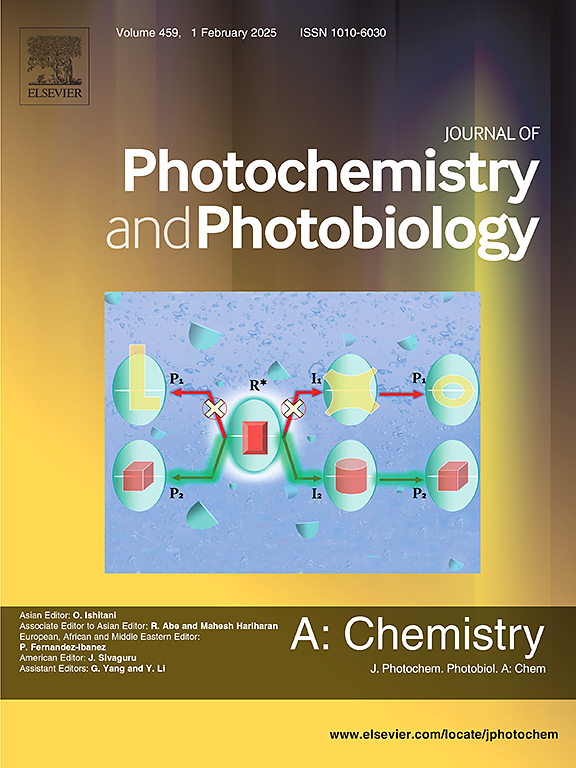绿色五氧化二铌纳米催化剂的可见光催化活性:实验分析和机器学习方法
IF 4.7
3区 化学
Q2 CHEMISTRY, PHYSICAL
Journal of Photochemistry and Photobiology A-chemistry
Pub Date : 2025-06-18
DOI:10.1016/j.jphotochem.2025.116585
引用次数: 0
摘要
本研究旨在从山核桃提取物中制备绿色Nb2O5-NPs,用于光降解六种有机染料,并通过机器学习研究预测其降解过程。在可见光下,120 min后染料的去除率最高可达71.5%,伪一级反应的表观速率k = 0.0034 min−1。DT算法表现出令人满意的效果(R2training = 0.9975 / R2test = 0.9945, RMSEtraining = 0.059 / RMSEtest = 0.094),在可见光照射下,预测300 min后MB染料去除率为75%。Nb2O5-NPs对Beta vulgaris L.种子具有较高的植物毒性(除50 mg L−1外),在所有浓度(12.5 ~ 100 mg L−1)下对甘蓝种子均无植物毒性。因此,本研究强调了将机器学习模型集成到催化研究中的重要性,为优化反应条件和指导可扩展的光降解过程提供了有价值的见解。本文章由计算机程序翻译,如有差异,请以英文原文为准。

Visible-light photocatalytic activity of a green niobium pentoxide nanocatalyst: Experimental analysis and machine learning approach
This work aims to develop green Nb2O5-NPs from Carya illinoinensis extract for the photodegradation of six organic dyes and to predict the reaction degradation progress through a machine learning study. 71.5 % removal was the highest value achieved for dye degradation after 120 min under visible radiation with the apparent rate of the pseudo first-order reaction k = 0.0034 min−1. DT algorithm showed satisfactory performance (R2training = 0.9975 / R2test = 0.9945, RMSEtraining = 0.059 / RMSEtest = 0.094), predicting 75 % of MB dye removal after 300 min under visible radiation. Nb2O5-NPs showed high phytotoxicity for Beta vulgaris L. seeds (except at 50 mg L−1) and no phytotoxicity for Brassica oleracea seeds in all concentrations tested (12.5–100 mg L−1). Therefore, this study highlights the importance of integrating machine learning models into catalytic research, offering valuable insights for optimizing reaction conditions and guiding scalable photodegradation processes.
求助全文
通过发布文献求助,成功后即可免费获取论文全文。
去求助
来源期刊
CiteScore
7.90
自引率
7.00%
发文量
580
审稿时长
48 days
期刊介绍:
JPPA publishes the results of fundamental studies on all aspects of chemical phenomena induced by interactions between light and molecules/matter of all kinds.
All systems capable of being described at the molecular or integrated multimolecular level are appropriate for the journal. This includes all molecular chemical species as well as biomolecular, supramolecular, polymer and other macromolecular systems, as well as solid state photochemistry. In addition, the journal publishes studies of semiconductor and other photoactive organic and inorganic materials, photocatalysis (organic, inorganic, supramolecular and superconductor).
The scope includes condensed and gas phase photochemistry, as well as synchrotron radiation chemistry. A broad range of processes and techniques in photochemistry are covered such as light induced energy, electron and proton transfer; nonlinear photochemical behavior; mechanistic investigation of photochemical reactions and identification of the products of photochemical reactions; quantum yield determinations and measurements of rate constants for primary and secondary photochemical processes; steady-state and time-resolved emission, ultrafast spectroscopic methods, single molecule spectroscopy, time resolved X-ray diffraction, luminescence microscopy, and scattering spectroscopy applied to photochemistry. Papers in emerging and applied areas such as luminescent sensors, electroluminescence, solar energy conversion, atmospheric photochemistry, environmental remediation, and related photocatalytic chemistry are also welcome.

 求助内容:
求助内容: 应助结果提醒方式:
应助结果提醒方式:


